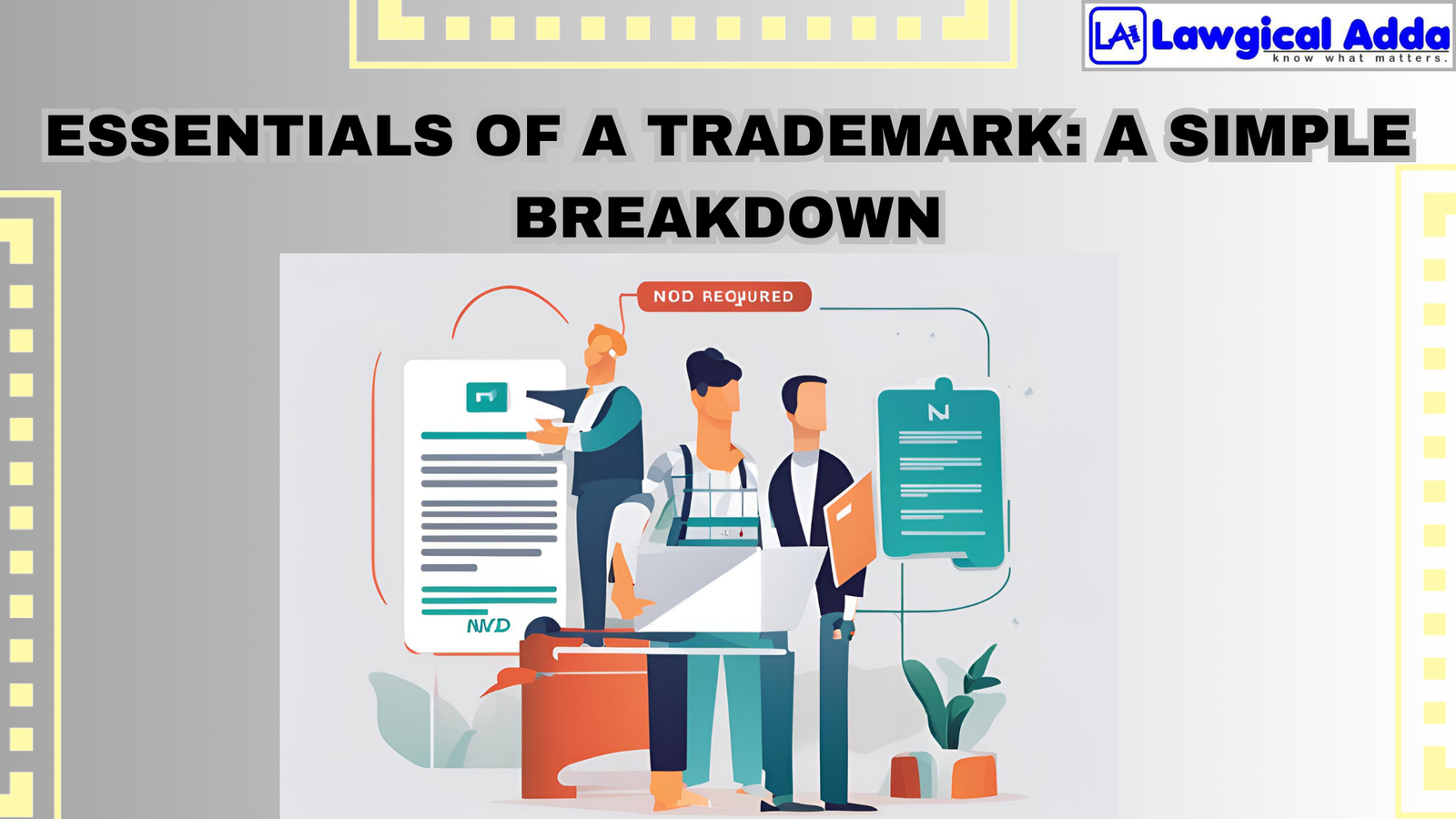Essentials of a Trademark: A Simple Breakdown

Table of Contents
Introduction
Any word, nickname, symbol, or other identifying mark used to identify and differentiate one item or service from another is considered a trademark. Moreover, trademarks identify the products’ origins even if the buyer isn’t aware of them.
Nowadays, the majority of consumers do not know the producer of the products directly, in contrast to earlier in the Industrial Revolution when there were few manufacturers and every buyer knew the creator personally.
In this article, Lawgical Adda will cover everything you need to know about the essentials of a trademark: a simple breakdown.
What is a Trademark?
A trademark is a quality or combination of attributes that allows one company to distinguish its products and/or services from those of competitors. Trademarks are protected under both local and international law and are considered intellectual property rights. Trademarks include the Apple computer’s bitten apple symbol, McDonald’s arched M, and Nike’s “Swoosh” logo.
Section 2(1)(i)(V)(m) of the Trade Marks Act of 1999 defines a “mark” as “a device, brand, heading, label, ticket, name, signature, word, letter, or numeral.” According to the Act, a product’s shape, packaging, color combination, or any other combination can all be designated a “mark.”
Functions of a Trademark
A trademark serves a variety of reasons, including showing the origin of goods, assuring quality, raising brand recognition, fulfilling marketing goals, and giving legal protection against counterfeiting and fraud. It ensures that the effort put into designing and selling a product, offering customer assistance, and backing up items with warranties is worthwhile.
Trademarks also offer legal protection against counterfeiting and fraud, guaranteeing that the work put into supplying customers is worthwhile. Finally, trademarks are utilized to set items apart from rivals, acting as a differentiating element under uniqueness. This guarantees that the promoted goods and services differ from those of rivals.
Subject Matter of a Trademark
The US Supreme Court’s 1879 Trademark Cases, which included alleged counterfeiting of champagne and whiskey markings, found that Congress lacks the authority to protect or regulate trademarks under the US Constitution’s intellectual property clause.
The Constitution’s Commerce Clause, however, gives Congress the authority to control trade in goods and services and trademarks. Trade dress is the outward look of a product or its packaging that serves as a consumer’s source indication, whereas trademarks, such as form, color, service, and sound, designate one specific feature of goods or products.
Trademark laws may also protect product packaging or trade dress. The Commerce Clause gives Congress the authority to regulate commerce with other countries, thus the Court did not completely rule out the prospect of Congress regulating trademarks.
Types of Trademark
- Service Mark
- Certification mark
- Collective mark
- Collective trade and service mark
- Collective membership mark
- Trade dress
- Non-conventional trademarks
- Wordmark
- Lettermark
- Logomark
- Combination mark
- Colour mark
- Shape mark
- Motion mark
- Sound mark
Essentials of a Valid Trademark for a Registration
In the 2014 US case of New York Pizzeria v. Ravinder Syal, the eatery asserted its trademark rights over the pizza taste, alleging that a former employee had stolen it. Dismissing the claim, the judge said flavors aren’t likely to be ‘inherently different’ since they don’t reveal the origin of the product. The case emphasizes the restrictions on what is considered a legitimate trademark.
The following are the essential requirements for a valid trademark:
- Firstly, any symbol or word combination that the trademark office or the court finds to be acceptable must be considered a trademark.
- Secondly, the trademark needs to be used to commercial endeavors.
- Thirdly, the trademark must distinguish the goods, services, or products from those of other companies.
- Finally, a trademark ought to be distinctive.
Need for Registering a Trademark
Trademarks are essential for product promotion and for granting the only right to sell products to particular people or businesses. They safeguard a brand’s reputation across the nation and stop other companies from stealing its intellectual property.
Nonetheless, trademarks are only given on a geographical basis, and without international registration, they lose their validity globally.A trademark’s value is increased by registration, which facilitates the sale of franchises and the granting of licenses to other parties.
Whereas a registered trademark enables the opposing party to establish their rights, unregistered trademark disputes place the burden of evidence on the owner.A trademark that has been registered provides protection against infringement by discouraging rivals from registering similar or identical trademarks.
In order to stop rivals from filing identical trademarks, the trademark office will not register any that are confusingly or “deceptively” similar. Additionally, trademark registration guards against fraud and fake goods.
When a trademark is registered, it will show up in the trademark register, which is where other people often go when selecting a brand. A trademark provides domain name protection for firms that operate online.
Conclusion
A trademark is a legally recognized document that certifies the ownership of a brand and identifies a product as belonging to a certain corporation. It aids in setting a product apart from competing offerings of comparable goods and services.
Trademark rules, while different in each country, all work toward the same goal of protecting a mark against imitators and helping to differentiate it from others. An international legal foundation for trademark owners is also provided by international treaties and agreements.



